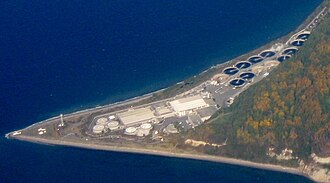The West Point Treatment Plant is a large wastewater treatment plant in Seattle. It is located in the Magnolia neighborhood, within Discovery Park. It is at the tip of West Point, near the West Point Lighthouse. The plant opened in 1966. It treats wastewater from the city of Seattle and other nearby communities. In 2017, the plant suffered a catastrophic flood that disabled it for months.

History edit
Before the plant was built, raw sewage flowed directly into the Puget Sound. The visibly polluted water often led to beach closures.[1] Communities surrounding Seattle dumped wastewater into Lake Washington, contaminating it as well. In 1958, voters created the Municipality of Metropolitan Seattle (Metro) to address this problem. Two treatment plants were planned, the West Point Treatment Plant in Seattle and the South Treatment Plant in Renton. West Point opened in 1966, providing primary treatment. In 1994, Metro was merged into the King County municipal government.[2][3] Secondary treatment was added to the plant in 1996 to meet federal Clean Water Act requirements.[4][5]
Operation edit
West Point is one of three major wastewater treatment plants in the area, alongside the South and Brightwater plants. The plant serves Seattle, Shoreline, and other surrounding areas of King County and Snohomish County. Some sewers draining to West Point are combined sewer systems, which carry both wastewater and stormwater. Upgrades are underway to strengthen this system against greater storms due to climate change.[6] The system currently treats approximately 90 million U.S. gallons (340 million liters) per day during dry conditions and over 300 million U.S. gallons (1,100 million liters) per day during wet conditions. Primary treatment is possible for flows up to 440 million U.S. gallons (1,700 million liters) per day.[7]
The plant begins with basic filtration and primary treatment. Secondary treatment consists of aeration tanks and clarifier tanks. Water is disinfected with hypochlorite before it is released into the Puget Sound.[8][9]
Solids are thickened and anaerobically digested. Gas from the process is burned for electricity to power the plant, and is sold as natural gas. The remaining solids are sold as nutrient-rich Loop biosolids, which are used for agriculture and habitat restoration.[10][8][9]
2017 flood edit
On February 9, 2017, the plant suffered from a massive flood. At about 2:12 AM, computer issues due to the flooding led to a massive discharge of wastewater directly into the Puget Sound. Over 180 million U.S. gallons (680 million liters) were released, including 30 million U.S. gallons (110 million liters) of sewage.[11] While water quality was not severely affected, the flood devastated the plant.[12] Many of the underground parts of the plant were flooded, requiring decontamination and costly repairs.[13][14] Furthermore, the flood destroyed the microbial communities in the anaerobic digesters. This compromised treatment capabilities even after the flood.[15]
References edit
- ^ Wilma, David. "Metro (Seattle) dedicates West Point Treatment Plant on July 20, 1966".
- ^ Crowley, Walt. "King County voters approve revised Municipality of Metropolitan Seattle (Metro) plan on September 9, 1958". HistoryLink. Retrieved 4 January 2024.
- ^ "History of our mission". King County. Retrieved 4 January 2024.
- ^ Wilma, David. "Secondary treatment of sewage begins at Seattle's West Point after years of controversy on December 31, 1995".
- ^ "History of our Mission". King County.
- ^ Zucco, Erica (14 June 2022). "Climate change one of the 'biggest concerns' for Seattle wastewater treatment plant". King 5 News.
- ^ "West Point Treatment Plant".
- ^ a b "West Point Treatment Process".
- ^ a b "How West Point processes Seattle's sewage". Seattle Times.
- ^ "Loop".
- ^ Long, Priscilla. "West Point Treatment Plant in Seattle suffers major failure on February 9, 2017".
- ^ Mapes, Lynda (28 February 2018). "West Point disaster sent raw sewage into Puget Sound. Surprisingly, the water quality was barely affected". Seattle Times.
- ^ "Millions of gallons of raw sewage gushing into Puget Sound after emergency". KIRO 7. 9 February 2017.
- ^ "'It's a war zone': How crews are braving raw sewage to fix the West Point treatment plant". Seattle Times. 25 February 2017.
- ^ Mapes, Lynda (12 March 2017). "Sludge bugs: Sewage-eating microbes in peril at crippled West Point plant".